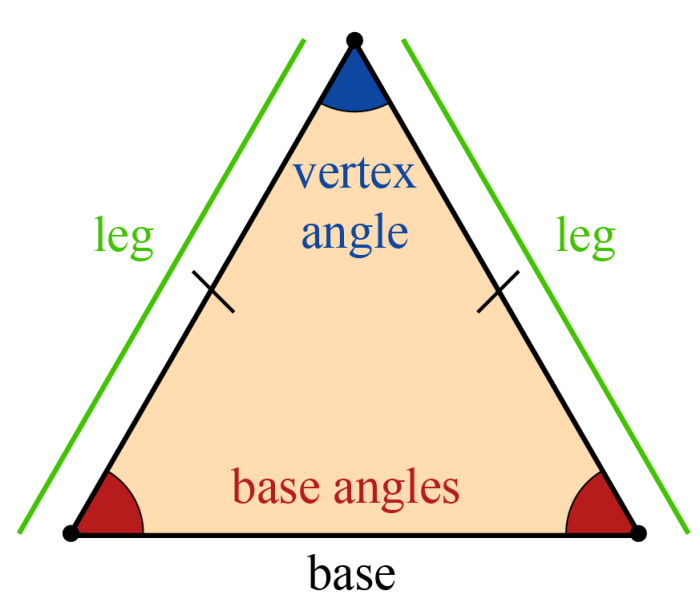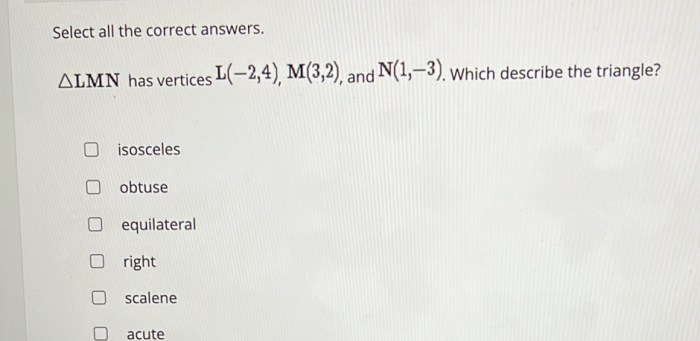Jefferson is plotting the vertices of an isosceles triangle – As Jefferson embarks on the task of plotting the vertices of an isosceles triangle, we delve into the fascinating world of triangle geometry. This exploration promises to illuminate the intricacies of isosceles triangles, their properties, and their practical applications.
In this discourse, we will navigate the Cartesian coordinate system, explore the concept of isosceles triangles, and unravel the secrets of their equal side lengths. Through a series of engaging examples, we will witness the power of the Pythagorean theorem in verifying the isosceles property and uncover the relationships between base angles and vertex angles.
Identifying Vertices
In geometry, a triangle is a polygon with three sides and three vertices. The vertices are the points where the sides intersect. An isosceles triangle is a triangle with two equal sides.
Properties of Isosceles Triangles, Jefferson is plotting the vertices of an isosceles triangle
- Two equal sides
- Two equal base angles
- One vertex angle
Plotting Vertices on a Coordinate Plane

The Cartesian coordinate system is a system for representing points on a plane. The plane is divided into four quadrants by the x-axis and the y-axis. The x-axis is the horizontal axis, and the y-axis is the vertical axis. The origin is the point where the x-axis and the y-axis intersect.
To plot a point on a coordinate plane, you need to know its x-coordinate and its y-coordinate. The x-coordinate is the distance from the point to the y-axis, and the y-coordinate is the distance from the point to the x-axis.
For example, the point (3, 4) is located 3 units to the right of the y-axis and 4 units above the x-axis.
Measuring Side Lengths

The distance between two points on a coordinate plane can be calculated using the distance formula:
d = √((x2
- x 1) 2+ (y 2
- y 1) 2)
where (x 1, y 1) and (x 2, y 2) are the coordinates of the two points.
For example, the distance between the points (3, 4) and (7, 10) is:
d = √((7
- 3)2+ (10
- 4) 2)
= √(16 + 36)= √52= 2√13≈ 7.21
Verifying Isosceles Triangle

The Pythagorean theorem can be used to determine if a triangle is isosceles.
a2+ b 2= c 2
where a and b are the lengths of the two equal sides, and c is the length of the third side.
For example, if a triangle has side lengths of 5, 5, and 8, then it is an isosceles triangle because 5 2+ 5 2= 8 2.
Properties of Isosceles Triangles
Isosceles triangles have several properties, including:
- The base angles are equal.
- The vertex angle is greater than either base angle.
- The sum of the base angles is equal to 180 degrees minus the vertex angle.
Applications of Isosceles Triangles: Jefferson Is Plotting The Vertices Of An Isosceles Triangle

Isosceles triangles are used in a variety of applications, including:
- Architecture
- Engineering
- Design
For example, isosceles triangles are used in the design of bridges, roofs, and other structures.
Q&A
What is the definition of an isosceles triangle?
An isosceles triangle is a triangle with two equal sides.
How do you plot the vertices of an isosceles triangle on a coordinate plane?
To plot the vertices of an isosceles triangle on a coordinate plane, you need to know the coordinates of the three vertices. Once you have the coordinates, you can plot the points on the plane and connect them with lines to form the triangle.
How do you verify that a triangle is isosceles using the Pythagorean theorem?
To verify that a triangle is isosceles using the Pythagorean theorem, you need to calculate the lengths of the three sides. If two of the sides are equal, then the triangle is isosceles.